Magazine
Running With The Bulls

A street where money talks and Indians trot.
It’s a place that Lakshmi, the Goddess of Wealth, would certainly approve of, devoted as it is to the creation of wealth and prosperity. When Indian Prime Minister Manmohan Singh wanted to showcase his new economic policy, he made a pilgrimage to the altar of high finance, the New York Stock Exchange. Over the years, one of the highest honors in the financial world is to be called to ring the opening bell on the trading floor, and high-flying ministers, finance gurus and CEOs of companies like Satyam and Tata Group have done just that.
No wonder then that for ordinary Indian immigrants, who have migrated to America in search of financial success, Wall Street is the golden Holy Grail, the Street of Dreams. Morgan Stanley, Merrill Lynch, Goldman Sachs, American Express – these names have been chanted in immigrant homes almost like a holy incantation and for a son or daughter to be hired by one of these major financial corporations is to see the crystallization of the American Dream. What started out as a tentative foray into Wall Street more than two decades ago has now become a full-fledged flood and Indian Americans are major players in almost every major financial house, from Citi Group to Lehman Brothers to UBS. No longer delegated to the backroom, several Indian Americans have emerged in leadership positions at leading firms. There’s Ravi Akhoury, chairman and chief executive officer of MacKay Shields, a multi-product investment management firm, affiliated with New York Life, with approximately $ 40 billion of assets under management. Rohit D’Souza is head of global equity markets, Global Markets & Investment Banking at Merrill Lynch, one of the world’s leading financial management and advisory companies, with offices in 36 countries and territories and total client assets of approximately $1.6 trillion. Ashwini Gupta is executive vice president and chief risk officer of American Express Company, and also heads the U.S. Banking Group, which is comprised of American Express Centurion Bank and American Express Federal Savings Bank.
Then there’s Prakash Melwani, a senior managing director in the private equity group at Blackstone Group, which is among the top 20 firms in the Fortune 500 listing. Its current $6.5 billion fund, Blackstone Capital Partners IV, is among the largest private equity funds in the world, and it recently closed on Capital Partners V at $5.6 billion. There are also superstars on Wall Street creating their own private equity funds. Vikram Pandit served as the president and chief operating officer of the Institutional Securities and Investment Banking Group at Morgan Stanley, drawing a salary in the millions with thousands of people reporting to him worldwide. Recently, he started his own private equity firm, Old Lane Management, with several ex-Morgan Stanley executives after a public struggle with former Morgan Stanley CEO Philip Purcell. The Economic Times reported, “Currently Old Lane Management is raising a $3-4 billion worldwide fund, one of the largest amounts ever raised by a hedge fund.” Another young financial superstar, Arshad Zakaria, former president of the Merrill Lynch Global Markets and Investment Banking Group, also went solo, founding the New Vernon India Fund that invests in India for Carnegie Corporation and other investors. The fortunes of Wall Street are increasingly linked with a new, powerful breed of Indian and Indian American bankers, money managers and analysts. Wall Street may be physically in Lower Manhattan – but it goes all the way to Mumbai or Bangalore. Indian American faces are now commonplace at all the major financial houses – from the swank corner offices to back offices providing analysis and technical support, the nuts and bolts which make the business go round. Indians have penetrated every aspect of Wall Street – as money managers, traders, portfolio managers, analysts or tech people. Goldman Sachs alone has an estimated 2,000 Indian employees.
Yet it wasn’t always so sunny. Ask Ravi Akhoury, who heads the $40 billion Mackay-Shields firm just how difficult it was for him to get to where he is today, and he laughs, “Yes, I think so. It was difficult for anyone, Indian or non Indian. I came in 1968 from IIT Kanpur and like most of us, I came with $8 in my pocket.” Akhoury came on a scholarship and got a masters in Quantative Methods from the State University of New York at Stony Brook. “In America we were in a big recession so it was very, very difficult to get a job, especially since I didn’t have a green card,” he recalls. “So it was a tough road and a tough climb. But this is America and I got my breaks early on. I was fortunate that I was given the opportunity to manage some portfolios and I developed a very good track record. One thing which is very good about the business we are in – it is a meritocracy in its true form.” Akhoury joined Mackay Shields in 1973 and became chairman and CEO of the company in 1992 and is also on the executive management committee of New York Life. When he took the reins, the company’s assets were $7 billion. He helped it diversify and with his team build it into a $40 billion multi-product company. He says, “It’s been hard, it’s been hard every year, but it’s also challenging and exciting.” A New York magazine article in 2002 captured the rise of immigrants in the business astutely. “During this very time in the early to mid-eighties, the next wave of outsiders, similar in many ways to the first wave, began to flood the street with résumés,” wrote Landon Thomas Jr. “They, too, were the sons (and daughters) of immigrant families, but now the families came from or still lived in places like Beirut, Bombay, Lahore, and Lagos. If anything, they may have been smarter than the first wave. Scholarship kids all, they had degrees spanning the quantitative realm: electrical engineering, physics, applied mathematics. No poli-sci majors here. These kids, growing up amid so much poverty, went to school to learn a trade, not to linger over the liberal arts.”
For many of the young Indian American foot soldiers, the most inspiring role model is Victor Menezes, who rose through the ranks to become one of the first big players on Wall Street. Menezes joined Citibank in 1972 and began his career in Asia. He was chairman and CEO of Citibank and head of Citigroup’s Emerging Markets business. He oversaw operations in 80 countries, and during his tenure the company had $13.5 billion in revenues, $200 billion in assets and 90,000 employees. Menezes retired in January 2005 as senior vice-chairman of Citigroup after a 32-year global career in the company. Indeed, the list of Indians in major corporations on Wall Street reads almost like a roll call. To name a few, at Deutsche Bank, Anshu Jain is head of Global Markets and a member of its executive committee. He is jointly responsible for managing the bank’s Euro 170 billion corporate loan portfolio. At Merrill Lynch, Purna Saggurti is head of multi industries investment banking, which includes aerospace and defense, chemicals and automotive sectors. On the consumer side, you have Ajay Banga, chairman and CEO of Citigroup’s Global Consumer Group International businesses, overseeing all credit card, retail banking and consumer finance operations in Asia, Japan, Europe, Middle East, Africa, Latin America and Mexico. Prakash Melwani of Blackstone Group came to Wall Street via Cambridge University and Harvard Business School. He founded Vestar Capital Partners before joining Blackstone Group. In his 20 years on Wall Street he has seen the growing presence of Indians in the financial sector. “When I first came in there were almost no Indians on Wall Street and most of the Indians tended to be less on the front end and more on the systems side. They were less visible,” he says. He points out that now one sees highly prominent Indians everywhere from private equity to hedge funds. “It’s just great, and even more so with the younger ones coming up through the ranks and I think the number of Indians in strong positions on Wall Street is just going to keep growing in the next five to ten years.” Subrata Chakravarty, a reporter at Bloomberg News, was with Forbes for 23 years and remembers those early days on Wall Street. “It was a different world. There were no Indian money managers that I ever saw and it used to be fairly unusual to read an Indian name on an analyst’s report,” he says. “Now you’re at the stage where there are serious money managers who are managing a lot of money for buyout firms and that’s just in New York. You’re not even going to Silicon Valley where there’s very serious money among venture capitalists who are Indian or Pakistanis. These are people who are in the position to make someone buy a company, sell a company, start a company.” So is there a glass ceiling that is difficult for Indians on Wall Street to penetrate? Says Prakash Melwani: “Not at all. Not an ounce and that’s what’s so fantastic about this country in general and that’s one of the reasons I chose to raise my children here. There is no glass ceiling anywhere, certainly not on Wall Street, which is the most meritocratic place in the world. It’s a remarkable place for talented Indians to work, because the sky’s the limit.”
Not surprisingly, Wall Street remains the street of gold that continues to attract second-generation talent. Sanjay Sanghoee, a graduate of Columbia Business School, was an investment banker with Lazard Freres and Dresdner Kleinwort Wasserstein before writing a novel, about Wall Street naturally, and also joining a hedge fund, Ramius Capital Group. “There’s a very large theater of Wall Street executives – mid-level to a step below senior level, which is increasingly being filled with South Asians,” he says. “I’ll go to any Wall Street or finance party and half the room is going to be Indians. A lot of them are coming from very diverse backgrounds; some of them have grown up here, others have come from IITs in India. Banking loves people from He believes that currently Indian Americans are probably the largest minority group working on Wall Street and their presence in investment banking and trading has grown dramatically, along with those in the IT sector. He says, “I can’t think of any other minority that is as largely represented. Perhaps you may have people of various Asian origin, but if you meet any four people on Wall Street, there’s a pretty good chance that at least one of them will be Indian.” Wealthy Indian Americans are also linked to Wall Street by their aggressive investments. While there are no statistics, Sanghoee believes that Indian Americans are heavily invested the stock market. So is Wall Street is the next frontier for Indian Americans, after medicine, motels and engineering? “Absolutely,” says Sanghoee. “This is a field which is very favored in the Indian American community. It’s not only acceptable, but very desirable for young Indians to be going into Wall Street. It’s an elegant profession in the view of the Indian community and it’s also a big money-making profession.” He finds that fewer Indian Americans are day traders, because the risk element is much higher and there is a tendency in the Indian mindset to shy away from risk. More Indians tend to go into investment banking and consulting, professions which are safe and stable. However, he says he sees a growing number going into real estate, biotech and hi-tech, historically areas that Indians did not venture into. Sanghoee says, “The younger generation I feel is leading the charge on that because they are a lot more open-minded, and they are also a lot more aggressive.”
Sanghoee, who is involved with hedge funds, says, “It’s an exciting, fast moving world. Hedge funds have raised a lot of money in the last five or six years and it’s a very good space to be in. You can look at all sorts of different sectors, different areas. The deals we get on our plate – no two deals are entirely alike. In investment banking you tend to see the same kind of deals over and over and over again.” Madhu Kannan is a vice president of the New York Stock Exchange, responsible for the initiatives in the emerging markets in Asia, with a primary focus on China and India. He says, “Our commitment towards India is beyond the listing business. We are also using India from a technology outsourcing perspective and there are at least three Indian companies working for us,” he says. “As a part of that process we end up having more people from India working on our projects on the backend and the number of Indian Americans working on the exchange has significantly increased in the last eight to nine years.” Kannan says, “If you use Wall Street as a much broader footprint for what’s going on, you see a much larger number of Indians and Indian Americans in the industry, be it trading, be it on the quantitative side or on the technology side. That’s a very clear trend in the last 8-9 years that I’ve been here.” He adds that Indians are also moving up the value chain, in senior leadership positions as well as in middle management positions in many of the major broker dealer houses on the street.
Several Indian companies are listed on the exchange and he adds, “Tata’s purchase of the Pierre and Tyco Internet cable – this is just the beginning of a whole new wave, which we’ve begun to experience where we are seeing the major Indian corporations now diversifying and mitigating risk by investing in the US. Now companies can argue it isn’t just American jobs going to India. It’s jobs being created right here on American soil for Americans by Indian investments. So it’s a very positive trend.” Ravilochan Pola is director and chief executive officer of Kotak Mahindra, Inc., the first India-based company to get its registration to deal with investors in the US for the securities market. The company is one of the largest financial services conglomerates in India and services 200 institutional investors who invest into Indian stocks, providing them research and execution of transactions. As to where Wall Street begins and ends, he points out that he has people in Hyderabad sitting at their laptops trading American deposit receipts on the New York Stock Exchange. He says, “So Wall Street is a very broad term used for people who are connected to the capital markets.” He also adds that the recruiting of personnel is occurring on both sides. Kotak Mahindra recently recruited Vikram Sood, a senior managing director at Citi Bank in New York, to be chief operating officer of the Kotak Mahindra Bank in India. So Sood moved from Scarsdale in New York to Mumbai with his family. When Pola’s predecessor Phalguni Nair went back as managing director of Kotak Mahindra Capital Company, her husband who was with Smith Barney in New York moved back to be chief executive officer of Citi Bank India. According to Ron Somers of the US India Business Council, based in Washington, D.C.: “I see that people who have come from India to the US are now interested in returning to India. That phenomenon was not even considered 12 years ago. Since these reforms have taken off, now you’re seeing more Indian Americans who are ready to return to the growing metros of Hyderabad, Pune, Chennai, Bangalore.” The USIBC members include at least 205 of the largest US companies investing in India and most of the Indian blue chip corporations that are investing in the United States. As Somers points out, CitiGroup has been investing in India since 104 years and scores of new financial companies are going in. He says, “They have understood the connectivity between the US and India on a 24 hour, 7 day basis. They understand how value-addition can be cultivated on the ground, in India, supporting investments there and maybe they are also looking to help Indian companies invest in the US. Now, more than ever, it’s a two way street.” One reason is that the gaps between salaries in the United States and India is narrowing. Professionals in the investment banking arena in India are commanding as much as $200,000 annually, and of course, the money goes much further there.
Besides the huge pool of talent in India, the country’s investment opportunities are whetting the appetite of Wall Street firms. “All these reasons allow many companies to be extremely active in India, whether it’s a Carlyle Group or Blackstone Group,” says Vishaka Desai, president of Asia Society, which just opened its offices in Mumbai. “Many hedge fund people are going there in a big way. They have certain connections in India, so they know that this in fact could be a possibility. They know that part of the world very well and have amassed a huge amount of capital.” Wall Street firms with a strong presence in India range from Warburg Pincus, which is the largest private equity investor in India, to the Chatterjee Group, headed by PC Chatterjee, and Desai Capital Management, headed by Rohit M. Desai. Blackstone Group is also a major player in India. Prakash Melwani is president and director of the India Fund, which is a $1 billion publicly traded mutual fund specializing in Indian stocks. The company’s private equity effort in India is headed by Akhil Gupta. Says Melwani, “Within a year Blackstone has gone from nowhere to basically committing a billion dollars to private equity and having this billion dollar public equity fund. So we have a real presence and real commitment to India.” While Melwani is primarily involved with major private equity transactions in the United States, he says the India Fund is seeing many Indian Americans buying into the fund. “It’s terrific. It’s one of the most pleasant side benefits of being involved with this – how many Indians have come up and told me they’ve invested in India. Indians are actually taking money back home which I hadn’t seen for a long time.” India watchers say that the privatization of Indian government companies has Wall Street firms, like Morgan Stanley, Goldman Sachs, Merrill Lynch, Bears Stearns and Lehman Brothers, salivating over the opportunities opened up for U.S. investors. As the financial markets take on a more global coloring, so will Wall Street. What will probably not change are the hectic hours and the heated 24/7 involvement. Some of the Indian financial wizards have turned to their cultural or spiritual roots for balancing their lives. Ravi Akhoury, for instance, is a devotee of Swami Chinmayanada and meditates regularly. He says, “Without a doubt it allows me to maintain a certain amount of calm, which is important to make good decisions. It calms your mind and slows you down, and gives you more energy.” Wall Street’s Midas touch can be intoxicating. Cautions Prakash Melwani: “At the end of the day it’s both good and bad. Everyone’s attracted to yesterday’s story and Wall Street has been so good for so long that everyone wants to come into it. I hope they are coming in for the right reason, which is they love finance. It’s a lot of hours, it’s very intense, it’s very consuming. A lot of people, not just Indians, are attracted to Wall Street for a lot of reasons, but the ones who really enjoy it are the ones who will still be here in 10-15 years.”
|

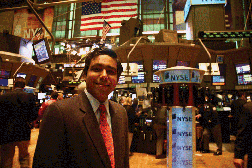
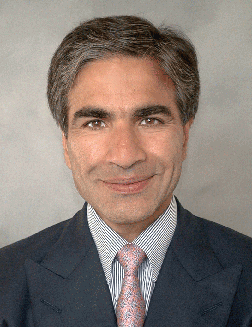

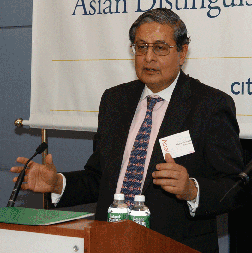
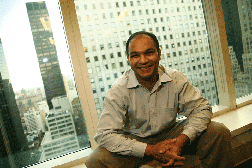
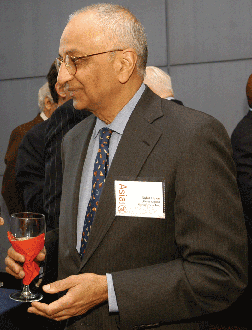
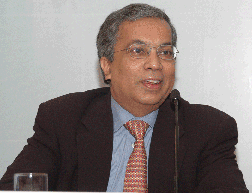
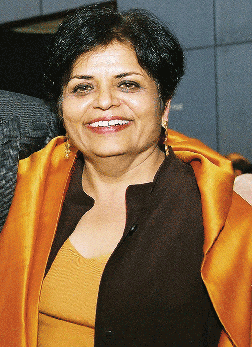
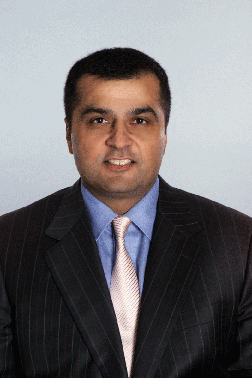
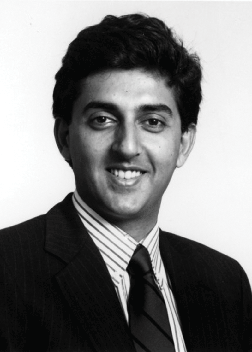

 VIKRAM SURI,
VIKRAM SURI,
You must be logged in to post a comment Login